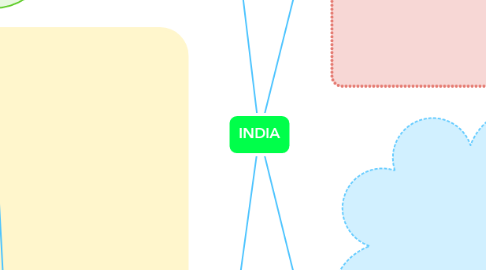
1. FOOD
1.1. The style of cooking varies from region to region.
1.2. Extensive use of spices and herbs.
1.2.1. Basil
1.2.2. Parsley
1.2.3. Thyme
1.2.4. Rosemary
1.3. Wheat, Basmati rice and pulses with Chana (Bengal gram) are important staples of the Indian diet.
1.4. The food is rich with curries and spices.
1.4.1. Ginger
1.4.2. Coriander
1.4.3. Cardamom
1.4.4. Turmeric
1.4.5. Dried hot peppers
1.4.6. Cinnamon
1.5. Chutneys — thick condiments and spreads made from assorted fruits and vegetables .
1.5.1. Tamarind
1.5.2. Tomatoes
1.5.3. Mint
1.5.4. Cilantro
1.6. Between 20 percent and 40 percent of India's population is vegetarian.
1.7. Muslims, Jews, Sikhs, and Christians all eat meat. The first three groups do not consume pork.
1.8. There is a wide array of breads served with meals.
1.8.1. Naan
1.8.1.1. A leavened oven-baked flatbread
1.8.2. Bhatoora
1.8.2.1. A fried, fluffy flatbread common in North India and eaten with chickpea curry.
2. TRADITIONS
2.1. Diwali
2.1.1. Is the largest and most important holiday to India.
2.1.2. It is a five-day festival known as the festival of lights because of the lights lit during the celebration.
2.1.3. Symbolize the inner light that protects them from spiritual darkness.
2.2. Holi
2.2.1. Festival of colours
2.2.2. Festival of love
2.2.3. Popular in the spring
2.3. The Namaste
2.3.1. Is one of the five forms of traditional greetings mentioned in the Vedas.
2.3.2. It literally translates to “I bow to you”.
2.3.3. Greeting one another with it is a way of saying “May our minds meet”.
2.3.4. It is indicated by the folded palms placed before the chest.
2.3.5. The Namaste, or ‘namaskar’, or ‘namaskaara’.
2.4. Gandhi's Birthday
2.4.1. October 2nd
2.5. Dance drama, based on the vast Indian mythology.
2.5.1. A dancer or performer narrates an entire story, almost entirely and exclusively through gestures.
2.5.1.1. • Bharatnatyam from Tamil Nadu
2.5.1.2. • Kathakali from Kerela
2.5.1.3. • Mohiniyattam from Kerela
2.5.1.4. • Kuchipudi from Andhra Pradesh
2.5.1.5. • Sattriya from Assam
2.6. Traditional brass and copper craft of utensil making.
2.6.1. Among the Thatheras of Jandiala Guru, Punjab.
2.6.2. It constitutes the traditional brass and copper making technique of utensils in Punjab.
2.6.3. Thantheras = metal copper.
2.7. Kalbelia folk songs and dances of Rajasthan
2.7.1. A community who are traditionally snake charmers.
2.7.2. They consider cobras to be sacred and carry them around in cane baskets with their Poongi (musical instrument).
2.8. Vedic chanting
2.8.1. Way of reciting the Vedas
2.9. Ramman
2.9.1. Religious festival
2.9.2. 18 people play 18 characters, wearing 18 masks to dance on 18 beats to celebrate the 18 puranas.
3. CULTURE
3.1. India's culture is among the world's oldest
3.2. Began about 4,500 years ago.
3.3. "Sa Prathama Sanskrati Vishvavara".
3.3.1. The first and the supreme culture in the world
3.4. Significant advances
3.4.1. Medicine
3.4.1.1. Ayurveda
3.4.2. Architecture
3.4.2.1. Taj Mahal
3.4.3. Mathematics
3.4.3.1. The invention of zero
3.5. Long history of war and conquest
3.6. Religions
3.6.1. Buddhism
3.6.2. Jainism
3.6.3. Hinduism
3.6.4. Sikhism
3.7. Ethnic groups, tribes, castes
4. MUSIC
4.1. Is based on a combination of rag (melodic form), tal (rhythmic form) and drone (sustained note).
4.2. Music Instruments
4.2.1. Sitar
4.3. Classic Music
4.3.1. Carnatic Music
4.3.1.1. Has developed in the south Indian states of Tamil Nadu, Kerala, Andhra Pradesh and Karnataka.
4.4. Film Music
4.4.1. Bollywood
4.5. Fusion
4.5.1. Begun with Ali Akbar Khan's 1955 performance
4.5.2. Begun with Ali Akbar Khan's 1955 performance
4.6. Ghazals
4.6.1. Traces its roots in classical Arabic poetry.
4.7. Folk
4.8. Singers
4.8.1. One of the basic ways through which a human being can connect with God.
4.8.2. Melodies
4.8.2.1. Ragas
